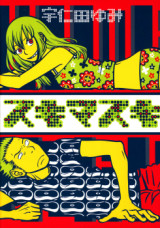This manga became a favorite of mine from the first chapter. I already love Unita's way of drawing hands and facial expressions (omg, the hands are amazing - actually, the entire style is just fantastic), so I was predisposed to enjoy this book if only because of the art. But the story!
Wow, the story is crafted really well. It's all about "looking through the gaps" or "looking through a lens", as shown through the two main characters, Heisaku (who watches his neighbor Fumio through the gap in her curtain, and likes to look through spaces or gaps in other things as well) and Fumio (who does photography, and mostly watches Heisaku through her camera lens from her room). So not only do we get the story about how they move from using these barriers to watch each other to actually entering each other's spaces, but these barriers and gaps appear everywhere. It's a visual motif, with the favorite meeting places having lots of vertical bars or windows, and it's a story motif as well. The reader is never able to fully know anything about any character, even the primary ones - what we do learn is like bits and pieces from a slide projector. Of course as the pov character, more is known about Heisaku than anyone else, but it's a slice-of-life story that doesn't give us a lot of background information, except what comes out in the dialogue. It's very tightly constructed, the story. As a result, even when we learn big information about a character, we're always left with the feeling that there's more to the story and what we've seen isn't as it seems at all.
The length of the story and the way it wraps up with a very ambiguous ending also matches that motif of "watching through the gaps". It's slice of life, so of course there's a feeling like that, but the shortness and abruptness amplifies the feeling. It's like when you're on a train and have just left one tunnel and are about to enter another - suddenly you see this panorama of cityscape or landscape or whatever out the windows, vibrant and expansive, and then just as suddenly you're thrust into the next tunnel without getting a really full view of what you'd past, and no longer able to go back to fill in the gaps that you missed. We don't know much, if anything, about Heisaku or his friends or Fumio before the story begins, and there are no signs at all about what happens after the story ends. We've seen this one instant, this period of several weeks, and that's it. But there doesn't need to be any more - even if the ending is ambiguous about what happens to the characters (is it a metaphor? is it literal?), the story that was meant to be told has been done and there's no more to say about it. Besides which, the ambiguity only emphasizes the "through the gaps" thing.
I guess it's probably clear that I love this manga. It's a slice-of-life character study, not really a romance at all, and has not only beautiful art but a tightly crafted story. It's one of my top recommendations for people looking for something that rises above the ordinary.





